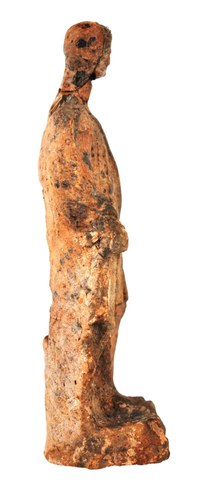Standing youth in a cloak, "Traveller"
|
Standing youth in a cloak, "Traveller", Inv. T I-26 Associated head: Inv. T I-27. Hollow. Front from mould, back not finished, slightly rounded, roughly smoothed, with large rectangular kilning hole. Head: Front and back from dies, joined. Provenance: Acquired by Bruno Sauer with special funds for the university anniversary in 1907. State of preservation: Head composed of several fragments, re-adjusted, erosions on the crown. Sloping fracture line through the neck. Abutments on the mantle and on the plinth. Heavily sintered. Dimensions: H: 25,0 cm; W: 9,1 cm; D: 6,3 cm. References: Not published. |
Description: The young man stands on a two-tiered plinth, which is rectangular at the front and rounded at the back. He wears a short-sleeved belted chiton reaching to the knees and a long cloak knotted on the right shoulder. This covers the left arm, embraces the right and fans out in folds on both sides. With his left hand the young man grasps the hem of the coat which runs diagonally across his chest. The feet with their high boots are turned slightly outwards.
The long slender neck carries a roundish head tilted to the right and turned to the left. It is covered with adjacent short wavy strands of hair. A transverse fold divides the forehead. Small eyes framed by plastically modelled lids lie under high orbitals deep in the sockets and wide apart. The taut cheeks end in a round chin. Under the straight nose, full lips form the closed mouth.
Commentary: T I-26 represents the type of the Epheben, a young man fit for military service. As the injuries on the crown indicate, he probably wore a headdress, the petasos[1]. Variants of the type could be designed as warriors[2], also as boys, in each case with the corresponding variations in stance motif and costume[3].
The head of the Giessen Epheben shows the characteristics of the late 4th century BC with its short, asymmetrically coiffed loosened strands of hair, the small deep-set eyes and the domed forehead crossed by a transverse furrow[4]. The parallels were mostly created in Boeotia. The clay colour of the specimen T I-26 also fits in with this landscape of origin.
Determination: 300 BC; Boeotia (Tanagra).
 |
 |
 |
|---|
[1] L. Burn – R. Higgins, Cat. of Greek Terracottas in the British Museum III (London 2001) 65 no. 2120 pl. 22; F. W. Hamdorf, Die figürlichen Terrakotten der Staatlichen Antikensammlungen München (Lindenberg im Allgäu 2014) 214 f. D 184-186; E. Jastrow, Abformung und Typenwandel in der antiken Tonplastik, OPArch 2, 1941, 25 fig. 10 c, Kopf nach rechts gedreht; Winter 2, 1903, 237, 1.
[2] Im Panzer und mit erhobenem Arm, der durch einen Speer zu ergänzen wäre, R. Higgins, Tanagra and the Figurines (London 1987) 148 f. fig. 180
[3] P. Leyenaar-Plaisier, Les terres cuites grecques et romains (Leiden 1979) 109, nos. 219. 221 pl. 38; E. Paul, Antike Welt in Ton (Leipzig 1959) 85 no. 201 pl. 55.
[4] e.g. Apoxyomenos, B. Sismondo Ridgway, Hellenistic Sculpture I (Bedminster 1990) 73-75 pl. 35; M. Weber, Zum griechischen Atheletenbild, RM 103, 1996, 31-49 pl. 14 f.

